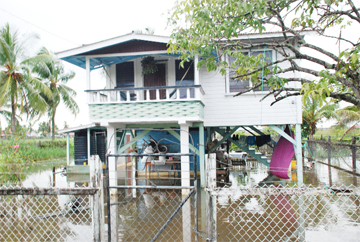The Government yesterday an-nounced that the Civil Defence Commission (CDC) has been mandated to prepare shelters for residents in flood-affected areas particularly those from the Mahaica, Mahaicony and Abary Creeks.
The step was taken since those districts are expected to be flooded for an extended period.

Head of the Presidential Secretariat and Cabinet Secretary, Dr. Roger Luncheon made the announcement at his weekly post-Cabinet press briefing yesterday. “There is no doubt that in some communities, particularly the creeks, the likelihood of flooding over an extended period is great and the school children, elderly they will benefit very well from being accommodated from the state expense under less hazardous conditions,” Dr. Luncheon was quoted by the Government Information Agency (GINA) as stating.
Preparations for shelter management are being wrapped up and stockpiling of necessary materials is also taking place, GINA said in a press release.
The move is the first significant action by the CDC following heavy rains in December that flooded several areas on the East Coast Demerara (ECD) particularly the community of Dochfour. After weeks of being inundated, the water in the community was finally pumped out this week. The water levels went up back yesterday after persistent rain. (See other story on centre pages.)
Late last month, the Maduni and Lama sluices were opened resulting in the Mahaica, Mahaicony and Abary Creek areas being flooded by high levels of water. High water continues to rise in those areas. The sluices were opened due to the high levels in the East Demerara Water Conservancy (EDWC) and to avoid a “major catastrophe”, the management of the EDWC had announced. Farmers have been badly affected and have lost their crops and many homes have been flooded.

Dr. Luncheon said yesterday that Cabinet at its last meeting concentrated on the work of the CDC and the Government agencies in their ongoing task of monitoring and assessing the floods. Asked about financing for the CDC to continue its work, he said that whatever the CDC needs to implement a Government disaster-relief mechanism will be met. He explained that at the time when a design is crafted for disaster, it is usually one that Government can fund. With respect to shelter management, Dr. Luncheon said that no new structures will be built, instead existing structures that were used for the 2005 flood will be utilized.
Meantime, the Cabinet Secretary noted that work would be expanded to improve interventions in food distribution in addition to the ongoing humanitarian responses that include public health and sanitation. GINA reported that the government has been making necessary interventions to bring relief to communities which are inundated. The CDC, other government and regional officials and Non-Governmental Organisations (NGOs) have been collaborating to render services to residents of affected communities, it said.
Outside of the humanitarian response, the Cabinet Secretary stated that Government will continue its technical work pointing out, that the projections are not favourable in that more extreme weather could continue until late April and noted that much of the interventions are being made in that context. Emphasis will be on continuing improvement in gravity drainage, the removal of all the obstacles that impair gravity drainage, man-made and otherwise, desilting outfalls and canals, garbage, and even to the sudden and inexplicable malfunction of drainage structures, he was reported as saying.
Dr. Luncheon asserted that focus will also be on improving mechanical drainage as this method is effective in draining water in the low-lying areas and noted that more will be done at the EDWC in the short and medium-term to render it less of a threat to the East Coast communities.
In late December, after weeks of flooding in some communities on the ECD, the CDC had been criticized for its response to the flooding by citizens group, Guyana Citizens Initiative.
In early December, head of the Commission Major General (ret) Michael Atherly had told this newspaper that the agency was ready and in an “alert phase”. He had declared that the CDC is always prepared to support the government and communities, particularly the vulnerable ones. He had noted that the commission had deployed to flooded East Coast Demerara communities and distributed water.
The CDC Head had emphasized that the agency was on standby and ready to move at a moment’s notice. Atherly had pointed out that the CDC was the coordinating agency between state agencies and other disaster response organizations like the Red Cross. He noted that the joint services provide manpower and equipment. “We do the coordinating work,” he had stressed. In this vein, he said that the agency has some basic first aid supplies. He had said at the time that to respond effectively, the CDC needs to intensify cooperation and coordination with the relevant state agencies.




